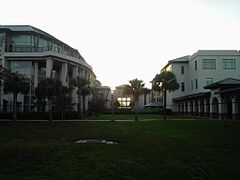Main article: Education in Florida
Primary and secondary education
Florida's public primary and secondary schools are administered by the Florida Department of Education. School districts are organized within county boundaries. Each school district has an elected Board of Education which sets policy, budget, goals, and approves expenditures. Management is the responsibility of a Superintendent of schools.The Florida Department of Education is required by law to train educators in teaching English for Speakers of Other Languages (ESOL).[217]
Universities
The State University System of Florida was founded in 1905, and is governed by the Florida Board of Governors. During the 2010 academic year, 312,216 students attended one of these twelve universities. The Florida College System comprises 28 public community and state colleges. In 2011–12, enrollment consisted of more than 875,000 students.[218]Florida's first private university, Stetson University, was founded in 1883. The Independent Colleges and Universities of Florida is an association of 28 private, educational institutions in the state.[219] This Association reported that their member institutions served over 121,000 students in the fall of 2006.[220]
Transportation
Main article: Transportation in Florida
Highways
Further information: State Roads in Florida
Florida's highway system contains 1,473 mi (2,371 km) of interstate
highway, and 9,934 mi (15,987 km) of non-interstate highway, such as
state highways and U.S. Highways. Florida's interstates, state highways, and U.S. Highways are maintained by the Florida Department of Transportation.In 2011, there were about 9,000 retail gas stations in the state. Floridians consume 21 million gallons of gasoline daily, ranking it third in national use.[221][222] Motorists have the 45th lowest rate of car insurance in the U.S. 24% are uninsured.[223]
Drivers between 15 and 19 years of age averaged 364 car crashes a year per ten thousand licensed Florida drivers in 2010. Drivers 70 and older averaged 95 per 10,000 during the same time frame. A spokesperson for the non-profit Insurance Institute said that "Older drivers are more of a threat to themselves."[224]
Before the construction of routes under the Federal Aid Highway Act of 1956, Florida began construction of a long cross-state toll road, Florida's Turnpike. The first section, from Fort Pierce south to the Golden Glades Interchange was completed in 1957. After a second section north through Orlando to Wildwood (near present-day The Villages), and a southward extension around Miami to Homestead, it was finished in 1974.
Florida's primary interstate routes include:
 I‑4, which bisects the state, connecting Tampa, Lakeland, Orlando, and Daytona Beach, connecting with I-75 in Tampa and I-95 in Daytona Beach.
I‑4, which bisects the state, connecting Tampa, Lakeland, Orlando, and Daytona Beach, connecting with I-75 in Tampa and I-95 in Daytona Beach. I-10, which traverses the panhandle, connecting Pensacola, Tallahassee, Lake City, and Jacksonville, with interchanges with I-75 in Lake City and I-95 in Jacksonville.
I-10, which traverses the panhandle, connecting Pensacola, Tallahassee, Lake City, and Jacksonville, with interchanges with I-75 in Lake City and I-95 in Jacksonville. I-75, which enters the state near Lake City (45 miles (72 km) west of Jacksonville) and continues southward through Gainesville, Ocala, Tampa's eastern suburbs, Bradenton, Sarasota, Fort Myers and Naples, where it crosses the "Alligator Alley" as a toll road to Fort Lauderdale before turning southward and terminating in Hialeah/Miami Lakes having interchanges with I-10 in Lake City and I-4 in Tampa.
I-75, which enters the state near Lake City (45 miles (72 km) west of Jacksonville) and continues southward through Gainesville, Ocala, Tampa's eastern suburbs, Bradenton, Sarasota, Fort Myers and Naples, where it crosses the "Alligator Alley" as a toll road to Fort Lauderdale before turning southward and terminating in Hialeah/Miami Lakes having interchanges with I-10 in Lake City and I-4 in Tampa. I-95, which enters the state near Jacksonville and continues along the Atlantic Coast through Daytona Beach, the Melbourne/Titusville, Palm Bay, Vero Beach, Fort Pierce, Port Saint Lucie, Stuart, West Palm Beach, and Fort Lauderdale, before terminating in Downtown Miami, with interchanges with I-10 in Jacksonville and I-4 in Daytona Beach.
I-95, which enters the state near Jacksonville and continues along the Atlantic Coast through Daytona Beach, the Melbourne/Titusville, Palm Bay, Vero Beach, Fort Pierce, Port Saint Lucie, Stuart, West Palm Beach, and Fort Lauderdale, before terminating in Downtown Miami, with interchanges with I-10 in Jacksonville and I-4 in Daytona Beach.






No comments:
Post a Comment